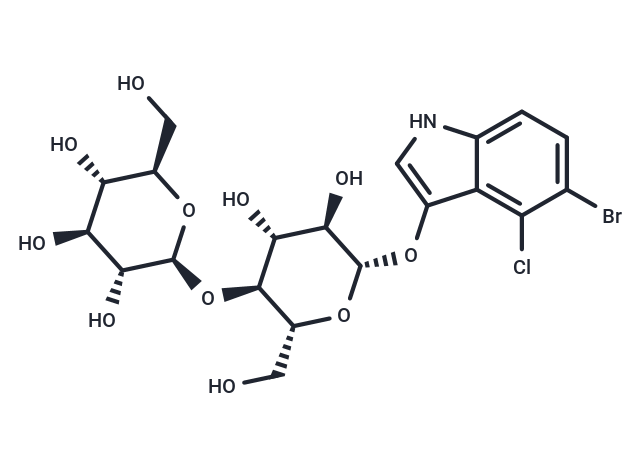Shopping Cart
Remove All Your shopping cart is currently empty
Your shopping cart is currently empty
5-Bromo-4-chloro-3-indoxyl-beta-D-cellobioside is a chromogenic compound used to detect cellobiohydrolases.

| Pack Size | Price | USA Warehouse | Global Warehouse | Quantity |
|---|---|---|---|---|
| 10 mg | $31 | - | In Stock | |
| 25 mg | $54 | - | In Stock | |
| 50 mg | $81 | - | In Stock | |
| 100 mg | $120 | - | In Stock | |
| 500 mg | $297 | - | In Stock | |
| 1 mL x 10 mM (in DMSO) | $35 | - | In Stock |
| Description | 5-Bromo-4-chloro-3-indoxyl-beta-D-cellobioside is a chromogenic compound used to detect cellobiohydrolases. |
| In vitro | I. Cellulase activity detection 1. Prepare substrate solution: Dissolve 5-Bromo-4-chloro-3-indoxyl-beta-D-cellobioside in an appropriate buffer solution, usually at a concentration between 0.5-1 mM. Commonly used buffer solutions include citric acid-phosphate buffer (pH 5.0-7.0) or Tris-HCl buffer (pH 7.5-8.5). 2. Add sample: Add the sample to be tested (e.g., bacterial culture or extract containing cellulase) to the substrate solution. The sample may contain related enzymes such as β-glucosidase. 3. Reaction conditions: Incubate the reaction system at a suitable temperature (e.g., 37°C) for a reaction time of 30 minutes to 2 hours. The enzyme-catalyzed reaction produces a blue product. 4. Stop the reaction: Stop the reaction by adding an appropriate chemical reagent (e.g., an acidic buffer) to prevent further activity of the enzyme. 5. Observe and analyze: Observe the blue product in the sample by naked eye or microscope. The appearance of blue products indicates the activity of cellulase. The activity of the enzyme can be evaluated by quantitatively analyzing the intensity of blue staining. 2. Fiber biotransformation research 1. Cultivation of microorganisms: Cultivate fiber-degrading microorganisms, such as cellulose-degrading fungi or bacteria, in appropriate culture media. 2. Addition of substrate: Add 5-Bromo-4-chloro-3-indoxyl-beta-D-cellobioside solution. 3. Reaction observation: Monitor the progress of the degradation reaction by color change. The color of the reaction product can help determine whether the microorganism has the ability to degrade cellulose. 3. High-throughput screening 1. Sample preparation: Process a large number of microbial samples (such as different strains or genetically engineered strains) in batches. 2. Substrate reaction: Mix 5-Bromo-4-chloro-3-indoxyl-beta-D-cellobioside solution with the sample. 3. Color detection: Use automated equipment to detect the blue reaction in different samples and quickly screen out efficient cellulose-degrading strains or enzymes. IV. Enzyme activity determination 1. Prepare substrate solution: dissolve 5-Bromo-4-chloro-3-indoxyl-beta-D-cellobioside in buffer. 2. Add test enzyme solution: add solution containing test cellulose hydrolase or other related enzymes. 3. Observe reaction results: evaluate enzyme activity based on color change. |
| Molecular Weight | 570.77 |
| Formula | C20H25BrClNO11 |
| Cas No. | 177966-52-8 |
| Smiles | O(C=1C=2C(NC1)=CC=C(Br)C2Cl)[C@@H]3O[C@H](CO)[C@@H](O[C@@H]4O[C@H](CO)[C@@H](O)[C@H](O)[C@H]4O)[C@H](O)[C@H]3O |
| Storage | store at low temperature,keep away from direct sunlight | Powder: -20°C for 3 years | In solvent: -80°C for 1 year | Shipping with blue ice/Shipping at ambient temperature. | |||||||||||||||||||||||||
| Solubility Information | DMSO: 22.5 mg/mL (39.42 mM), Sonication is recommended. | |||||||||||||||||||||||||
Solution Preparation Table | ||||||||||||||||||||||||||
DMSO
| ||||||||||||||||||||||||||
| Size | Quantity | Unit Price | Amount | Operation |
|---|

Copyright © 2015-2026 TargetMol Chemicals Inc. All Rights Reserved.